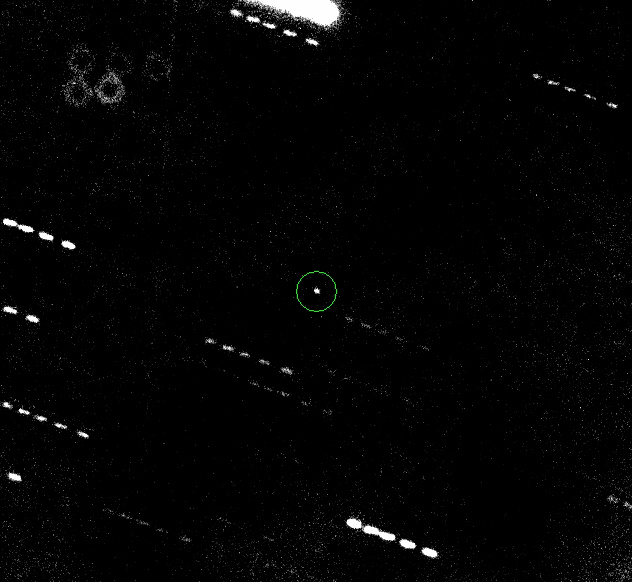[/caption]
Asteroid Apophis continues to be an object of interest for astronomers. Even though the possibility of an Earth impact by the now-famous asteroid has been ruled out during its upcoming close encounter on April 13, 2029, this close flyby will significantly change Apophis’s orbit, and astronomers are uncertain how that could affect future encounters with our planet. For that reason, astronomers have been eager to obtain new data to further refine the details of the 2029 encounter. However, for three years, the asteroid’s orbit had it “hiding” behind the Sun, but it has now emerged. This newest image of Apophis was taken on January 31, 2011, using the University of Hawaii’s 2.2-meter telescope on Mauna Kea, and astronomers from UH at Manoa say they will make repeated observations of this potentially dangerous near-Earth asteroid.
Astronomers measure the position of an asteroid by comparing with the known positions of stars that appear in the same image as the asteroid. As a result, any tiny error in the catalog of star positions, due for example to the very slow motions of the stars around the center of our Milky Way galaxy, can affect the measurement of the position of the asteroid.
“We will need to repeat the observation on several different nights using different stars to average out this source of imprecision before we will be able to significantly improve the orbit of Apophis and therefore the details of the 2029 close approach and future impact possibilities,” said astronomer David Tholen, one of the co-discoverers of Apophis, who made the latest observations along with graduate students Marco Micheli and Garrett Elliott.
They obtained the new images when the 270-meter (900-foot) diameter asteroid was less than 44 degrees from the sun and about a million times fainter than the faintest star that the average human eye can see without optical aid.
The astronomers will be taking advantage of Apophis’s position for the next few months, as its elliptical orbit around the Sun will take it back into the sun’s glare this summer, making observations – and measurements of its position – impossible. However, in 2012, Apophis will again become observable for approximately nine months. In 2013, the asteroid will pass close enough to Earth for ultraprecise radar signals to be bounced off its surface.
“Radar observations are important because we can estimate orbital parameters and provides us lots of information about an asteroid’s surface features and internal structure, and how they may have formed,” said Lance Benner, an astronomer at JPL, who specializes in radar imaging of near-Earth asteroids. “We need to know these things if we are going to deflect one of these.” Speaking at the American Geophysical Union conference in 2009, Benner said radar is the most powerful astronomical technique for both finding new asteroids and measuring their orbits.
“We can measure their velocity to less than 1mm per second, and do this up to 20 million kilometers from earth. Radar helps us compute the trajectory much farther into the future – even up to 300 years, giving us much more advance notice.” Benner said they can routinely image asteroids at 7.5 meters per pixel, and a new system at the Goldstone radar facility will be able to get the resolution down to 1 meter per pixel.
On April 13, 2029, Apophis will come closer to Earth than the geosynchronous communications satellites that orbit Earth at an altitude of about 36,000 km (22,000 miles). Astronomers say Apophis will then be briefly visible to the naked eye as a fast-moving starlike object.


Since 2029 is a long way out, wouldn’t it make sense to take some kind of action now? I would think the cost would be much less than if we waited a decade? And even though we know the asteroid is most likely going to miss us, this could be a good chance for us to test out the best theories now that we have the chance (and could compensate for any whoopsies that may happen)?
What about sending a small orbiter and perform the gravity tug option?
CW. out of the 1/250.000 chances of collision this means that in 249.999 times the asteroid will miss Earth. The asteroid is destined to fail by nature by a factor for 24,999,900 procent!
Oh I know that it’s going to miss us. But wouldn’t this be an ideal object to at least try some of the theories that’ve been proposed (at least the theories that are the least expensive, such as the gravitational tug)?
If you sit down and calculate the acceleration a gravitational tug of 5 tons mass at 100 m distance can effect on Apophis, you find that it will take some 1000 years to move Apophis (some 35 million tons) by one meter this way.
It is evident that trying to deflect that Asteroid this way is as effective as emptying Lake Ontario by means of a spoon.
Ah, I didn’t know that GBendt. Thanks.
I bet a low yield nuclear blast would move it.
What are those 5 cycles in the top of the image?
I bet a low yield nuke would do the trick. I bet the tree huggers would come unglued to boot!
Even so, there is no clear evidence that any of these Asteroid Apophis the truth about biggest Full Moon after 18 Years Supermoon 19th March 2011 http://itwel.com/biggest-full-moon-after-18-years-supermoon-19th-march-2011.php